 The Man Trap
The Man Trap
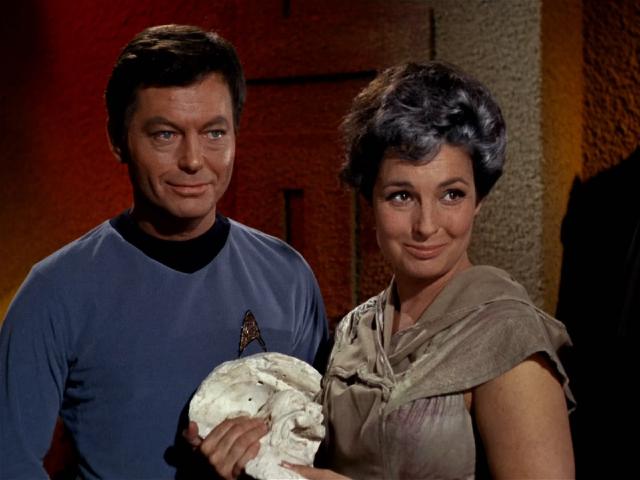
Review
Here we go - the very first episode of Star Trek to air.
Today it might seem strange for a series to start with a monster-of-the-week episode rather than one that explicitly introduces the show’s world, characters, and themes. But this was 1966 - before streaming, before DVD, before home video. Star Trek was written to have its episodes broadcast and rebroadcast in varying order such that viewers could jump in anywhere and not be lost. Consequently, there is no true starting point. Characters and relationships are largely static and most episodes don’t make specific references to previous ones.
With that context, it’s understandable how “The Man Trap” could have been chosen as the first episode to air. It’s a straightforward plot that presents drama and danger based on an intriguing sci-fi premise but which is still easy to follow. The audience can be drawn in but be free to focus on learning about the setting and characters.
The episode does spend some time on character- and relationship-establishing scenes, some of which fit the story more naturally than others. Kirk and McCoy’s friendship is clearly shown by the good-natured ribbing from Kirk over McCoy’s history with Nancy and McCoy’s good-humored response to it, and this history is actually plot-relevant.
Uhura and Spock fare rather worse, getting an awkward conversation on the bridge with no plot significance. But some of this awkwardness is likely due to the age of the episode. Uhura seems disappointed that Spock - her commanding officer - is uninterested in flirting with her. As a modern viewer familiar with Spock’s disposition and expecting professional behavior from officers of any gender, I find that the scene makes Uhura look like she’s pointlessly flinging herself at Spock out of a specific interest in him paired with a complete lack of understanding of his Vulcan approach to emotion. I suspect when written (by a man in the 1960s) it was actually intended to showcase that Vulcan approach - of course the woman in the workplace wants attention from the man in charge, and how weird and alien that this man isn’t playing along with this beautiful woman!
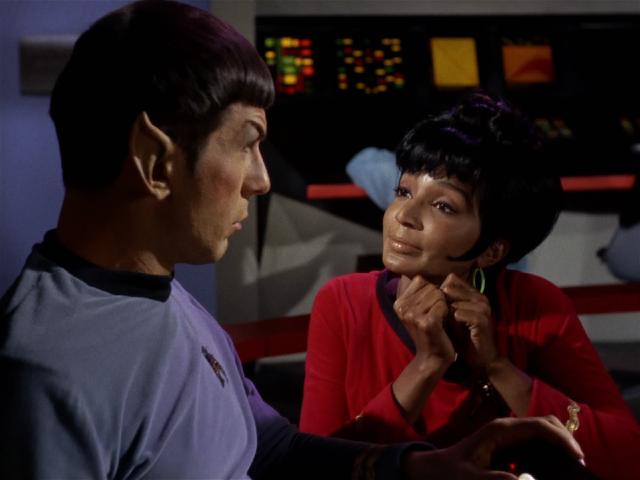
Sulu and Rand’s botany lab scene lands somewhere in the middle - their interactions are cute, but tell you less about the characters and still clearly carry the casual sexism that plagues The Original Series. (I’m mostly not going to comment on that sexism outside of egregious cases - it’s obvious and omnipresent. I’m just acknowledging it up front so we can accept that it’s there and move on.) And it’s a little frustrating that while the scene is technically plot-relevant, Rand and Sulu have almost nothing to do with that and their conversation could be about literally anything. Instead, the plot-relevant character in this scene is a plant: the amazing Beauregard/Gertrude.
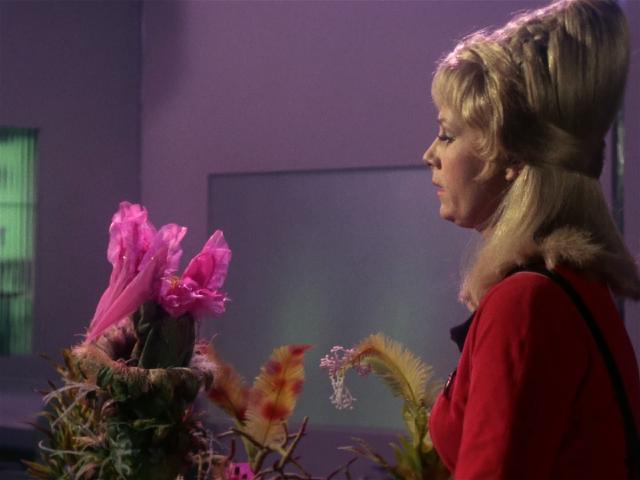
I love Beauregard. How can you not love a vampire-detecting plant that is obviously a hand in a glove?
But let’s talk about that plot. It’s basically a sci-fi horror film: The crew stumbles into a deadly scenario (even failing to heed the warnings of the curmudgeonly local), struggles to get control of it while people keep dying, and eventually learns enough about the monster to triumph over it. And viewed as a horror film, it’s not bad. There’s some good foreshadowing and tantalizing hints as more of the mystery is revealed over time. The premise of the salt vampire is an interesting sci-fi twist on a standard plot - yes, it’s a deadly creature that can impersonate your allies, but it both impersonates and kills in an unusual way, and it’s apparently intelligent and not exactly evil. Unfortunately “The Man Trap” fails to embrace that implied moral ambiguity and as a result it doesn’t really work as a Star Trek episode.
This was the first Trek to air and one of the first handful to be written and produced. We now think of Trek as what it eventually grew into and how it eventually distinguished itself from other cautionary-tale sci-fi. Trek is an optimistic view of science and progress that emphasizes the value of diversity, truth-seeking, and compassion. But that doesn’t seem to be the case yet in “The Man Trap”.
Robert Crater doesn’t kill the M-113 creature even after it kills his wife. Instead he learns to communicate and coexist with it. He protects it and provides it with salt in a sustainable relationship that appears to be friendly or even loving. This compassionate behavior seems in line with what you’d expect from Starfleet based on later Trek installments, yet here Crater is painted as misguided. Kirk even suggests that Crater’s motivation is not the prevention of the final extinction of an intelligent race, but rather the companionship of an apparent shape-shifter.
Kirk’s interpretation is a bit more plausible given that Crater doesn’t report to Starfleet that he’s made contact with a previously-unknown race and established peaceful relations - instead, he tries to hide the creature and shoo away the Enterprise. But given the way Kirk and company react once the truth comes out, it’s hard to argue that Crater was wrong to do this. It’s true that the creature has killed multiple crewmen by this point, but Crater’s experience suggests that it was acting out of self-preservation and that simply providing it with a supply of salt would render it harmless. Kirk seems uninterested in this perspective and views the creature only as a threat to be eliminated, despite it being the last of an intelligent race.
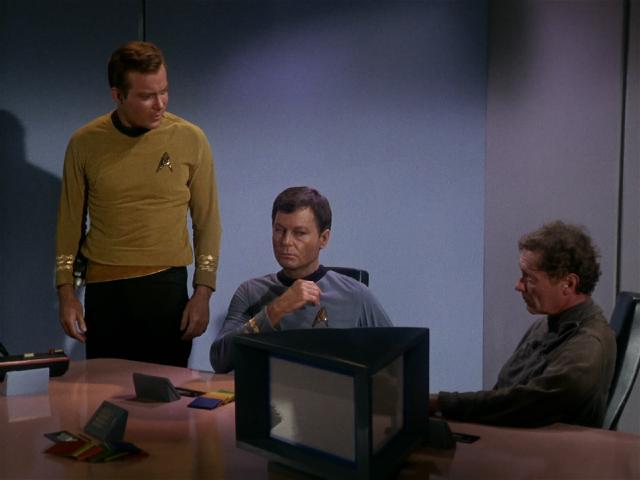
The events of the episode seem to show that Kirk is right and that Crater’s compassion is misplaced. Crater claims that the M-113 creature is intelligent and not a danger if provided with salt - and while that seems to have been true in its time with Crater before the episode, it does not match the creature’s behavior during the episode. It goes on a totally unnecessary killing spree (it could easily have gotten salt without killing anyone) with its final murder being Crater himself, despite him having just shown himself to be the creature’s most reliable defender.
Kirk closes the episode by saying, “I was thinking about the buffalo, Mr. Sulu,” referring to the parallel Crater drew earlier between the M-113 creature and Earth’s by-then-extinct species. But as Kirk had pointed out to Crater in response, the M-113 creature had killed Kirk’s crewmembers. That seemed to make it not worth preserving. McCoy isn’t even called out for killing the creature instead of stunning it so that it may be subdued and a non-lethal resolution sought.
In the end, “The Man Trap” is a simple monster story with shallow morality where the heroic thing to do is to kill instead of to understand. This works as the conclusion to a sci-fi horror movie. It doesn’t work as the conclusion to a Star Trek episode. And that’s why I can’t quite recommend this episode - especially as an introduction to the series or franchise.
Assorted Observations
By this point, not all the details of the crew’s various gadgets had been worked out yet, which is unsurprising for one of the first-produced episodes. But the example that stands out to me is the way phasers work when Kirk and Spock are trying to catch Crater. Kirk tells Spock to put his phaser on “one quarter” (phaser settings are generally not given in fractions) and that Kirk will keep his own on “stun”, which rather-famously does continue to be a phaser setting moving forward. But when Kirk shoots Crater, the result isn’t the now-familiar loss of consciousness. It’s more literal - Crater is “stunned” as in “dazed”, losing his balance and becoming disoriented. I find this to be a compelling difference - I’m not surprised that later episodes (and all subsequent series) have used “stun” as in “knock unconscious” as this seems more convenient for storytelling purposes. But I enjoy imagining what things would be like if the writers had chosen to have the stun setting always work this way instead.
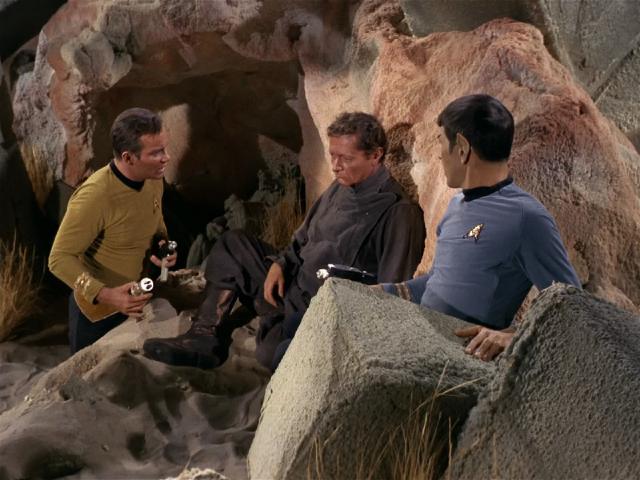
The role and nature of Starfleet also doesn’t seem to have been worked out. The senior staff seem competent and reliable but some of the lower-ranking crewmen act in a wildly unprofessional way (see especially Darnell in the beginning of the episode). While The Next Generation will later establish Starfleet as an inherently elite institution that takes only the best and brightest, The Original Series often portrays it as something that must be easier to get into - the cream rises to the top, but the rank and file are not always paragons.
Spock claims that his ancestors “spawned in another ocean” than Kirk’s, explaining that the differences in his blood cells are likely the reason the creature did not drain him. Early episodes seemed to paint Spock as much less human than he is; we will later learn that Spock has a human mother which means he actually shares that ancestry with Kirk. This does make lines like these technically inaccurate, but the way this is resolved is by having Spock clearly identify much more as Vulcan than Human, which leads to some fantastically compelling character exploration for him over the years so I’m not even a little mad about it.
The M-113 creature’s intelligence and self-control seem to vary to suit the needs of the plot at any given moment. Sometimes it’s able to act exactly as expected for the person it’s imitating; other times it’s distracted by the availability of salt or a potential victim and acts in a way that others find off-putting or creepy. Sometimes it’s able to resist any desire to feed on humans, as it’s apparently left Crater unharmed for a year or two and it doesn’t attack McCoy when he’s vulnerable. But whenever it’s alone with an unimportant member of the crew, it kills them and doesn’t hide the corpse - despite this drawing more attention and putting it in more danger, especially compared to the much superior option of just getting actual salt from the ship’s stores, which it seems smart enough to recognize as a possibility. Instead, it drains at least four crewmen and its lone defender Crater over what seems like a period of several hours at most (and it still seems compelled to consume more). Crater claims that the creature “is not dangerous when fed” but if it needs to feed that frequently, it seems impossible that Crater would still be alive when the episode begins.
The mechanics of the creature’s camouflage are also somewhat unclear. We sometimes see the creature when nobody is around, maintaining the last appearance we saw it with and occasionally changing to a new one before interacting with anyone else, which suggests an actual persistent physical change (which is the explanation proffered by startrek.com’s database). But that seems impossible since it was seen differently by Kirk, McCoy, and Darnell simultaneously in their first encounter, plus we know that it’s able to pull images and thoughts directly from people’s minds (as it does when it meets Uhura in the guise of a person she was imagining and speaks Swahili to her) and seems to have the ability to put people into something like a hypnotic trance. This suggests that the disguise is telepathic in nature: the creature doesn’t actually shape-shift; it reaches into its viewer’s mind and makes them see a familiar or desired image. The scenes that suggest a physical change are likely just a convenience for storytelling purposes - it would be much harder to convey what’s going on without this approach, at least not without showing the creature’s true form much earlier and spoiling the reveal.
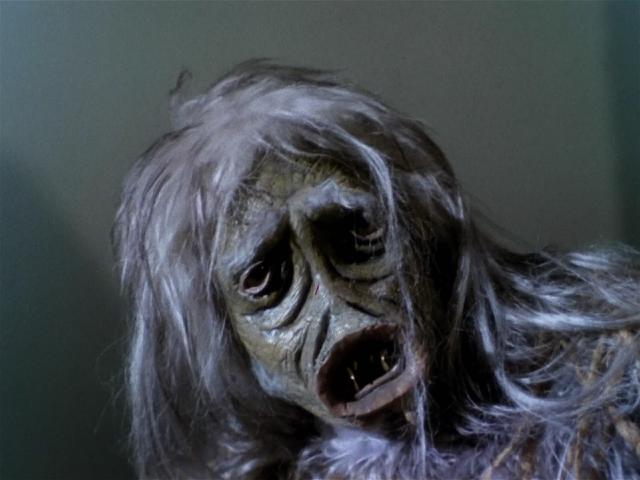
And that reveal is fantastic. There’s a reason the salt vampire is one of the most iconic one-shot creatures in The Original Series - it’s an excellent example of storytelling through costume design. The creature’s true form instantly explains the red mottling on the victims' faces via the suckers on its long fingers, and even better, the creature manages to simultaneously look horrifying and sad. Its face is that of the lone survivor of a once-great race, reduced to a monster by its insatiable hunger. A tragic villain.